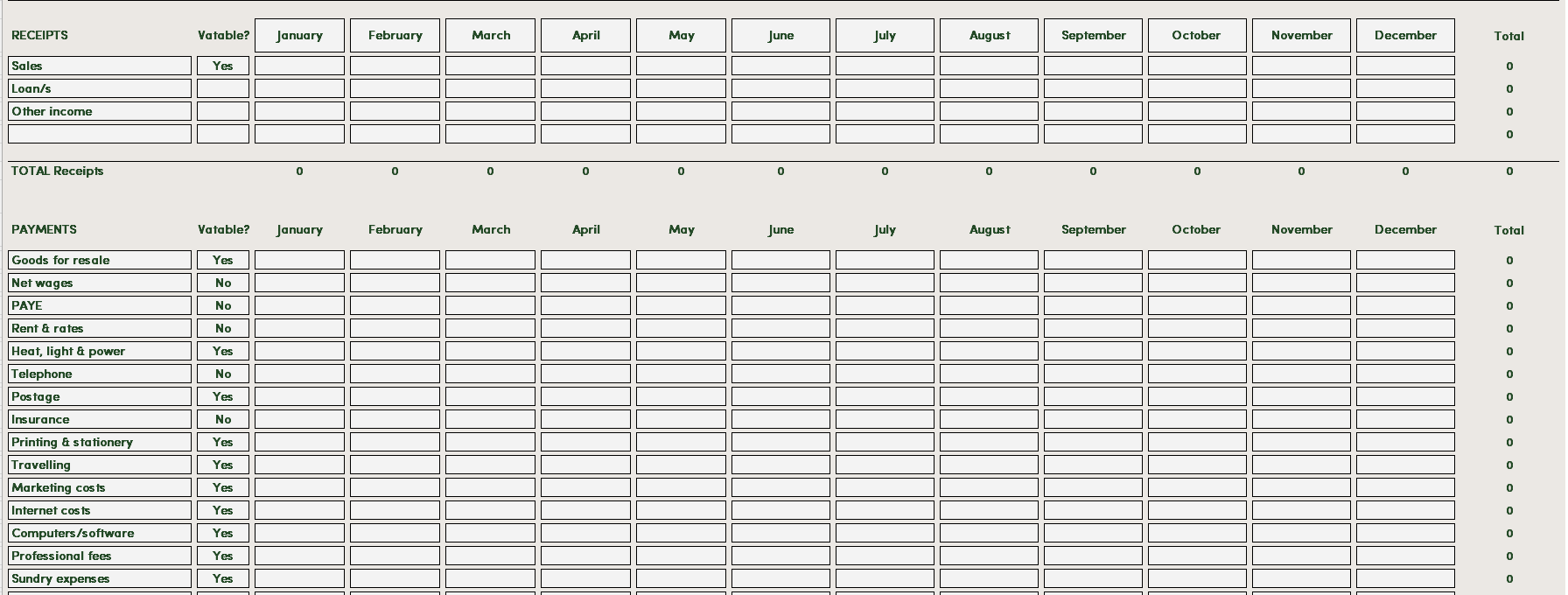None of these work, I’ll have to make one for you

How I made a cash flow forecast tool that works
You know that feeling? When you’re 100% sure that someone must have already made the tool or app you need to do a particular job, you Google around to find one you can grab and use. But you can’t find anything that works?
Soooo….annoying.
I had this a couple of years ago when I needed a cash flow forecast tool for one of my clients. We needed to check how her company’s cash flow was going and what would happen if she recycled some of her cash to invest in a couple of new products.
I looked around for a cash flow spreadsheet to help her do this properly. Unfortunately, the free ones made it even more confusing or didn’t work correctly. I ended up downloading about 20 different cash flow forecast tools and swearing to myself at my desk because they either didn’t add up the numbers or didn’t include VAT. If you’re a UK business, you’ll know that your quarterly VAT payments to the government have the biggest impact on your cash flow. Apart from paying staff, of course.
I did find some expensive apps that link to your accounts software and supposedly help you plan your cash flow. But these were too much for small businesses like hers. And there is an irony in paying out £35 per month (+VAT) to help you feel secure about your cash flow.
Because I couldn’t find anything that was, to paraphrase William Morris, both beautiful and useful, all the cashflow forecast tools I looked at were confusing, misleading, or too ugly to use.
So I made one myself
I needed to help my client. So I just made one myself. I knew that small business owners have better things to do than mess about with confusing spreadsheets, so I made it very simple to use. And then, I got an Excel wizard to check it out and make it beautiful. I was pretty pleased with it.

Then I put it on sale because I thought some people might want one, too. A bunch of people have bought it and used it. I used it myself as well, so it was a double whammy for me.
It’s pretty cool. It does all the adding up for you, takes the VAT into account correctly, and tells you what your next VAT payment will likely be. And the effect that this will have on your cash flow.
It’s a work of art.

But. Was making this a good idea?
I’ve made a little money from selling the cashflow forecast tool. But it’s not my most exciting or lucrative product. I’ve never promoted it; it wasn’t a planned part of my product ecosystem. These three facts are probably related, now I think about it.
I built the cashflow forecast tool very quickly, fueled by a quick spurt of annoyance that there wasn’t one already out there. Plus the desire to help my client make her investment decision based on a better understanding of the consequences for her business.
It wasn’t shiny object syndrome
Normally, I would frown if someone suggested just spinning up a new product with no planning or relationship to the other products in their ecosystem. Usually, this kind of thinking is a sign of shiny object syndrome. I bet you’ve done this, too – you have a brilliant idea, and that’s all you can think of for a few days. You’re desperate to get stuck into making this new shiny object.
And, of course, this is one of the ways that people get stuck with their digital products – following the shiny object and then losing interest and momentum.
Let’s think about how to avoid the failure of shiny object syndrome
The key to being able to spend a bit of time on making the cash flow forecast just because I wanted one is all about how fast I could get it done. It’s okay to spend time investigating a shiny object if this is just a bit of time. If I’d spent six months battling to make this, my Return on Effort would be pathetic. Especially if I didn’t get the damn thing on sale, which, let’s face it, is the case for many brilliant shiny object product ideas.
I was able to make the cash flow forecast tool very quickly because I’d already made one. I’d completely forgotten, but I’d made a similar tool for a friend’s book project about twenty years before this. And I’d looked at all those crappy free cash flow forecast tool templates, so I knew what I wanted instead.
I was well within my comfort zone with this one.
It’s essential to know Wizards
Now, I like a spreadsheet. My partner once walked into my home office and asked me what I was laughing at. She shook her head when I told her I was laughing at a spreadsheet because I could see the lies in it.
But I’m not at Wizard Level. I’d already made several spreadsheet-based products. I’d already found Pete, the spreadsheet Wizard, who could take my “it pretty much works but looks ugly” spreadsheet and make it beautiful and useful.

What I imagine Pete, the spreadsheet Wizard, looks like while he’s working.
This wasn’t my first rodeo
Making products gets easier as you go along. Your twentieth product will probably be about 10% as difficult as your first product. I was lucky that I’ve been making products since 2014, plus helping hundreds of clients get going with their product ecosystems, too.
Many people get stuck with selling digital products because they are too bothered about the whole e-commerce infrastructure. Often, this is a different kind of shiny object syndrome, where someone gets caught trying to decide how to sell a product before they’ve even started making it.
I was lucky because my web developer had suggested using Memberpress way back in 2014, so I already knew how to put my cashflow forecast tool on sale. Oh, look…that’s another case of knowing the right Wizard and following their advice.
Being open to partnerships and opportunities
I’ve already confessed here that I didn’t promote the cash flow forecast template much. In fact, I kind of forgot about it because I was working on other things, and my driving reasons for making it had already been resolved – I’d helped my client with her decision.
After it had been on my other website (the Joy of Business) for about a year, I got a random email asking if I would be open to including my cashflow forecast template in a bundle deal. You might have seen these bundle deals, where someone curates a collection of related books, apps and courses and bundles them together. They sell access to the bundle for a set price, and everyone who buys it can download whatever they want.

Effectively, this means giving my product away for free to a bunch of complete strangers in order to make money for a complete stranger. I was a bit dubious. But although I’ve bought a couple of these bundles, I’ve never been part of one before, so I thought I’d give it a go. I nearly gave up when it took me two hours to fill out some forms to be part of it, but I guess that’s why I have music on while I’m working, to help me with those boring bits.
This turned out to be a great idea and totally worth it. Now, pretty much every day, I get a “you’ve sold a thing” notification for the cash flow forecast tool. I don’t get the nice Stripe ping of money coming in as these notifications are someone claiming their freebie, but the bundle sales have substantially added to my email list. And…yes, dear reader, a few people have bought other products.
Freedom from the trap of trading time for money
One of the biggest motivations for me in building a product-based business is being free to decide when I work and what I do when I am working. I decided a few years ago that I wanted to break the relationship between how I spend my time and how I make my money and move away from set hours and constant client meetings.
Of course, this is still a work in progress, and there are still meetings, forms to fill out, and tasks that are not necessarily in my Zone of Genius. But I was able to spend the ten hours or so it took me to make a brilliant cashflow forecast tool and get it on sale because I don’t have to think about maximising my hourly rate anymore. If I’d only made the tool for that one client plus me, it wouldn’t have been worth my while to do it, and it would have stayed on the big list of things I’ll probably never do.
My top tips for giving yourself permission to make a random product
I’d love to know if this story fits with other people’s experiences of making a random product and it kind of working out. Especially if you have experience of being able to do this because you have the freedom to explore because you’ve made other products and got out of the trap of trading time for money.
Here are my personal guidelines for checking if you’re following the shiny object or adding a good one to your product ecosystem.
Check out the cash flow forecast tool I made. It’s a thing of beauty and usefulness – the only cash flow forecast tool you’ll find that will Include the all-important impact of VAT payments on your bank balance.
I use this cash flow forecast tool for my own business, and I’ve tested it with dozens of clients. It’s simple to use, you just pop in your numbers, and it works everything out for you.No more surprises – you’re in control of your finances.
Image credits – Vervate for photos of Julia Chanteray at her desk, Adobe stock images for Pete the Wizard and NASA on Flickr for a beautiful image of a quasar. Apparently, a quasar is the most shiny object in the universe.
